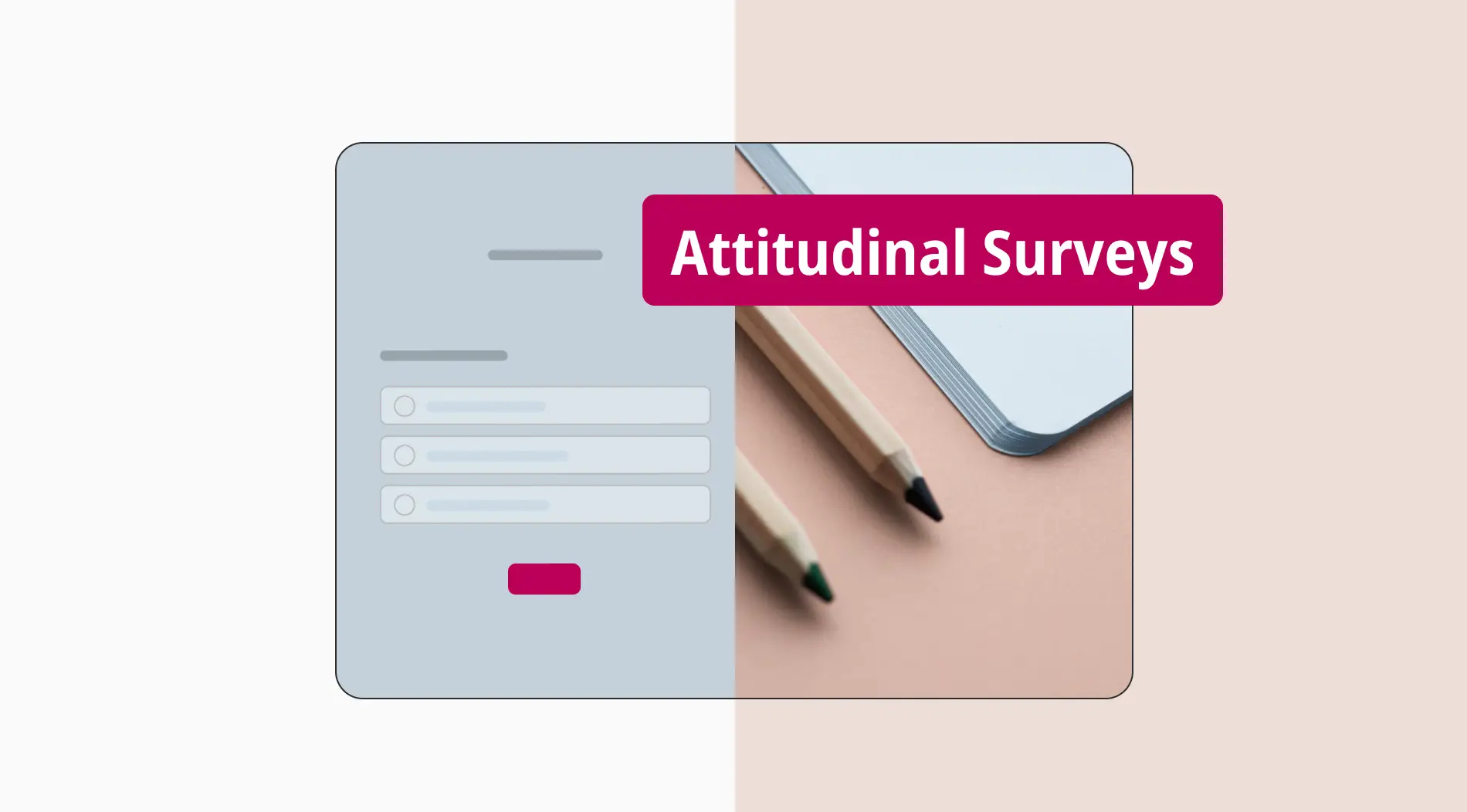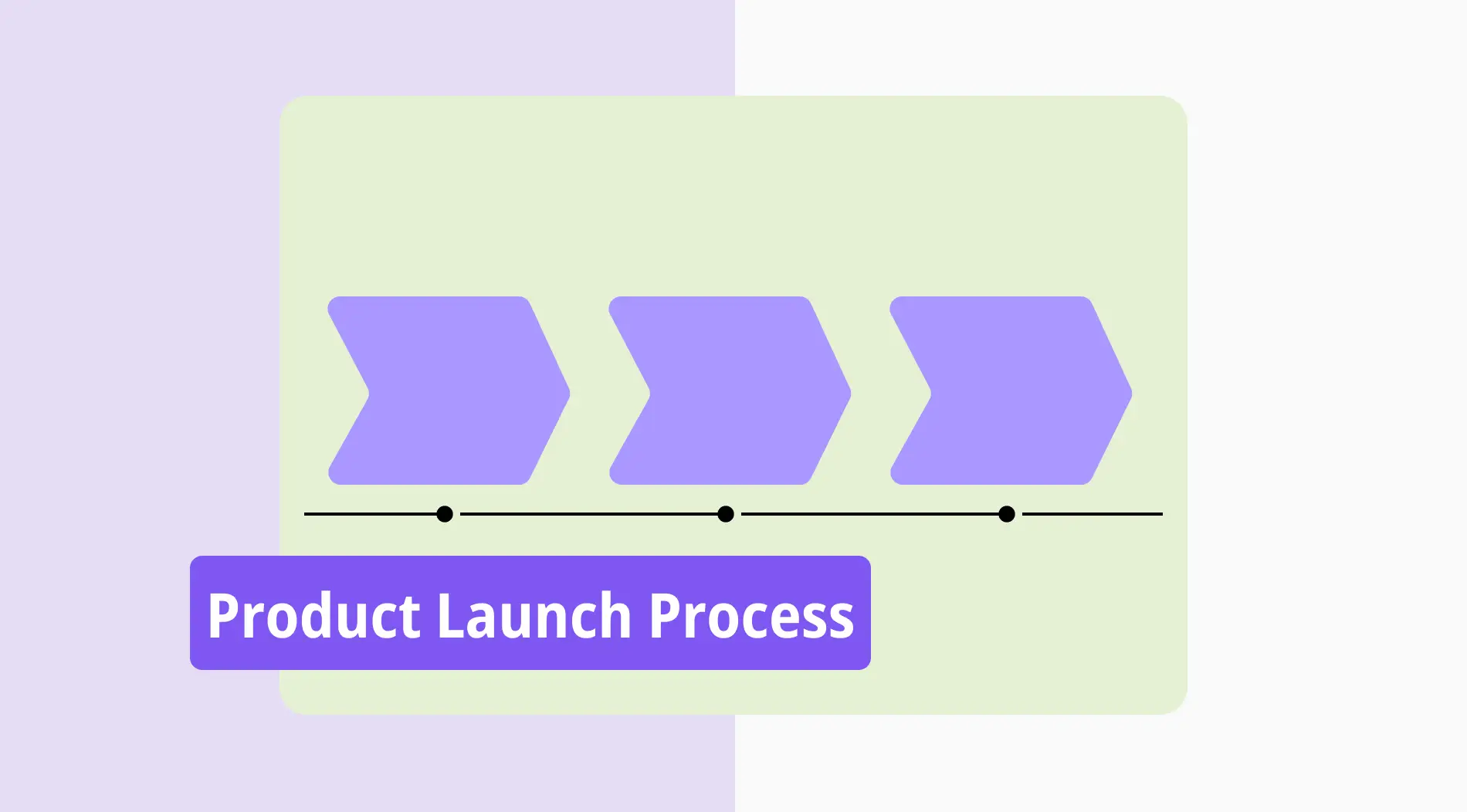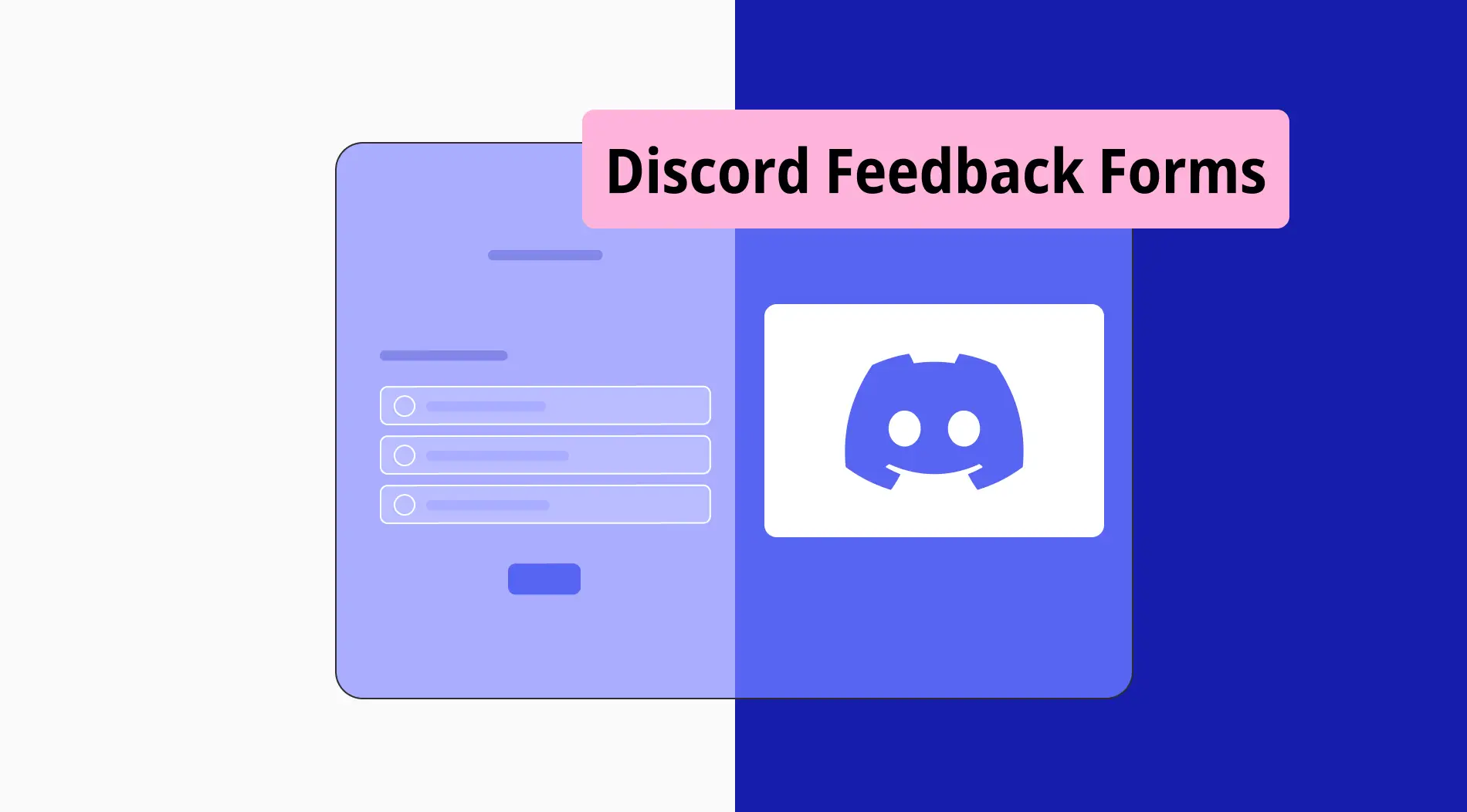Surveys and survey tools play a vital role in the modern business world. They provide your business with insights into customer preferences, employee satisfaction, and market trends. When you use these tools, your company can make data-driven decisions, enhancing your strategies and operations. Surveys help you gather real-time feedback, which is essential for continuous improvement.
Today, we will talk about attitudinal surveys. It is a powerful tool for understanding people’s opinions and attitudes towards various topics. You’ll learn when to use them and how to create them, as well as its different types. We’ll also provide some example questions you can use in your surveys and discuss the pros and cons. Finally, we’ll answer some common queries.
What is an attitudinal survey?
An attitudinal survey is a type of survey for measuring people’s feelings, beliefs, and attitudes on a specific subject.
Businesses commonly use an attitudinal survey for market research, employee satisfaction studies, and customer feedback evaluations. Unlike behavioral surveys, which focus on actions and experiences, attitudinal surveys dig deeper into the why behind people’s choices and opinions.
You can usually structure the questions in attitudinal surveys to capture your respondents’ feelings or perceptions. They often include Likert scale questions, where participants rate their agreement or disagreement with a statement or open-ended questions, allowing for more detailed responses. This combination of quantitative and qualitative data provides a well-structured view of the subject of interest.
Attitudinal survey types
Having introduced ourselves to the concept of attitudinal survey, let’s take a look at its types. There are a variety of attitudinal surveys your business can use, from Likert scales to open-ended surveys. Understanding these types will enable you to use the correct version for your business goals.
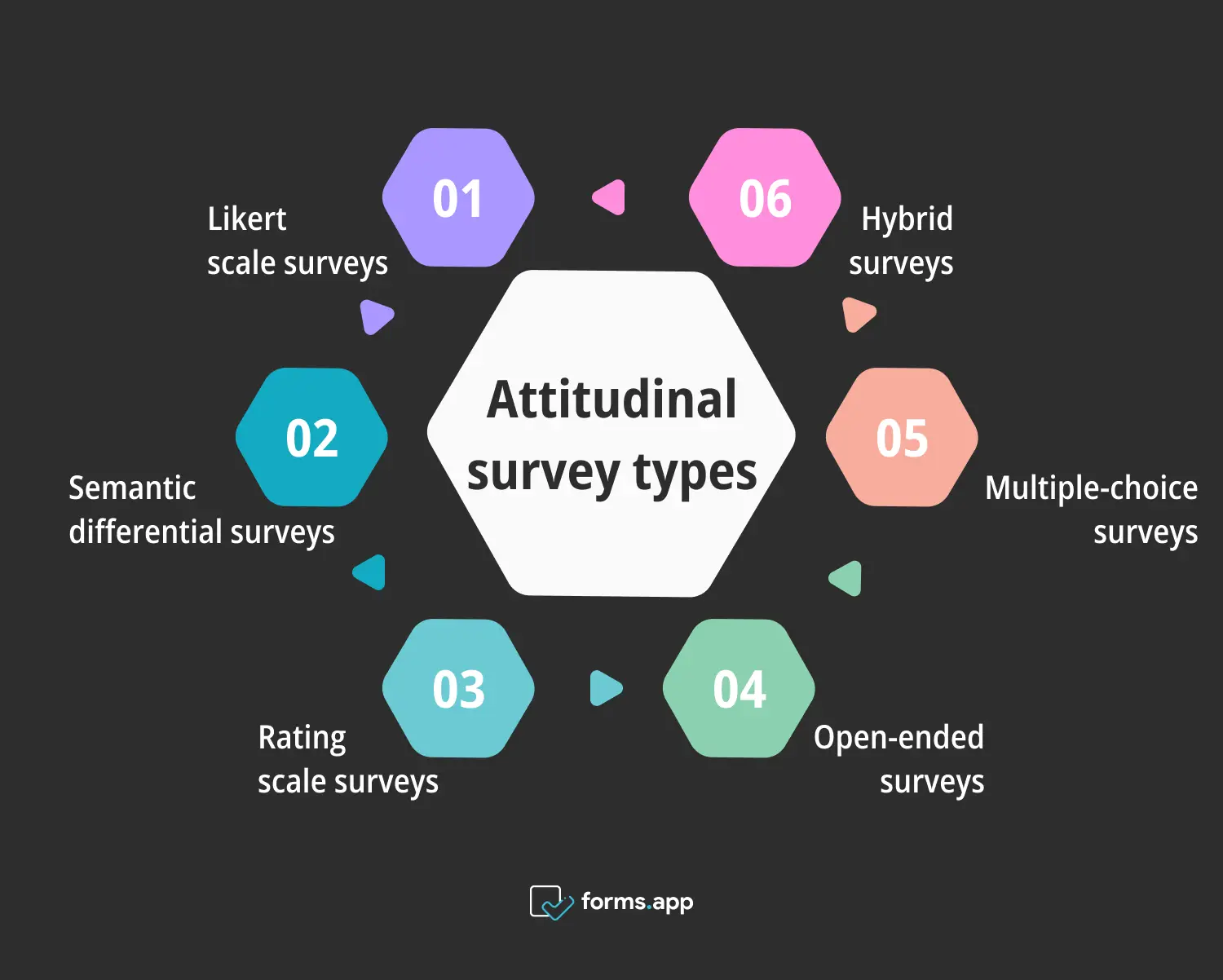
Types of attitudinal surveys
1- Likert scale surveys
Likert scale surveys are the most common attitudinal survey type. They ask respondents to rate their level of agreement with a statement on a scale, typically from 'strongly disagree' to 'strongly agree.' This method is very effective for quantifying opinions and feelings for analyses.
This allows for easy comparison as well. You can use Likert scale surveys in customer satisfaction studies, employee engagement surveys, and public opinion research. It provides a clear and measurable understanding of people’s attitudes on a certain matter.
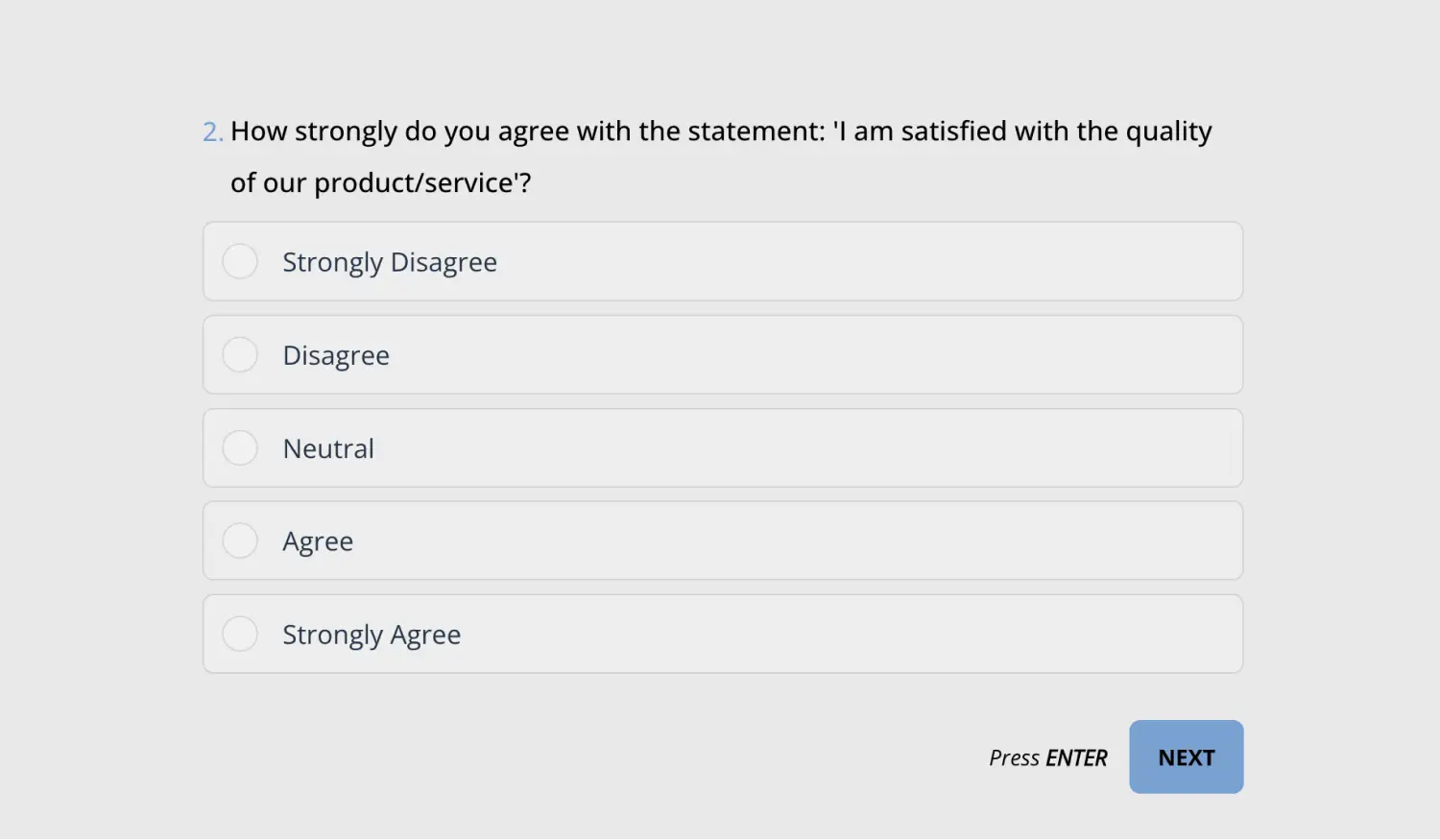
An example Likert scale question
2- Semantic differential surveys
Semantic differential surveys use a series of opposite/bipolar adjectives such as happy vs. unhappy. Its aim is to measure the respondents’ attitudes toward a particular concept, product, or brand. Participants can select a point on a scale between two opposite words reflecting their feelings or perceptions.
This type of survey is useful for you to capture the nuances of attitudes. You can also use it for brand perception studies, market research and product evaluations. Semantic differential surveys provide a detailed view of how people perceive specific attributes. This enables more targeted improvements.
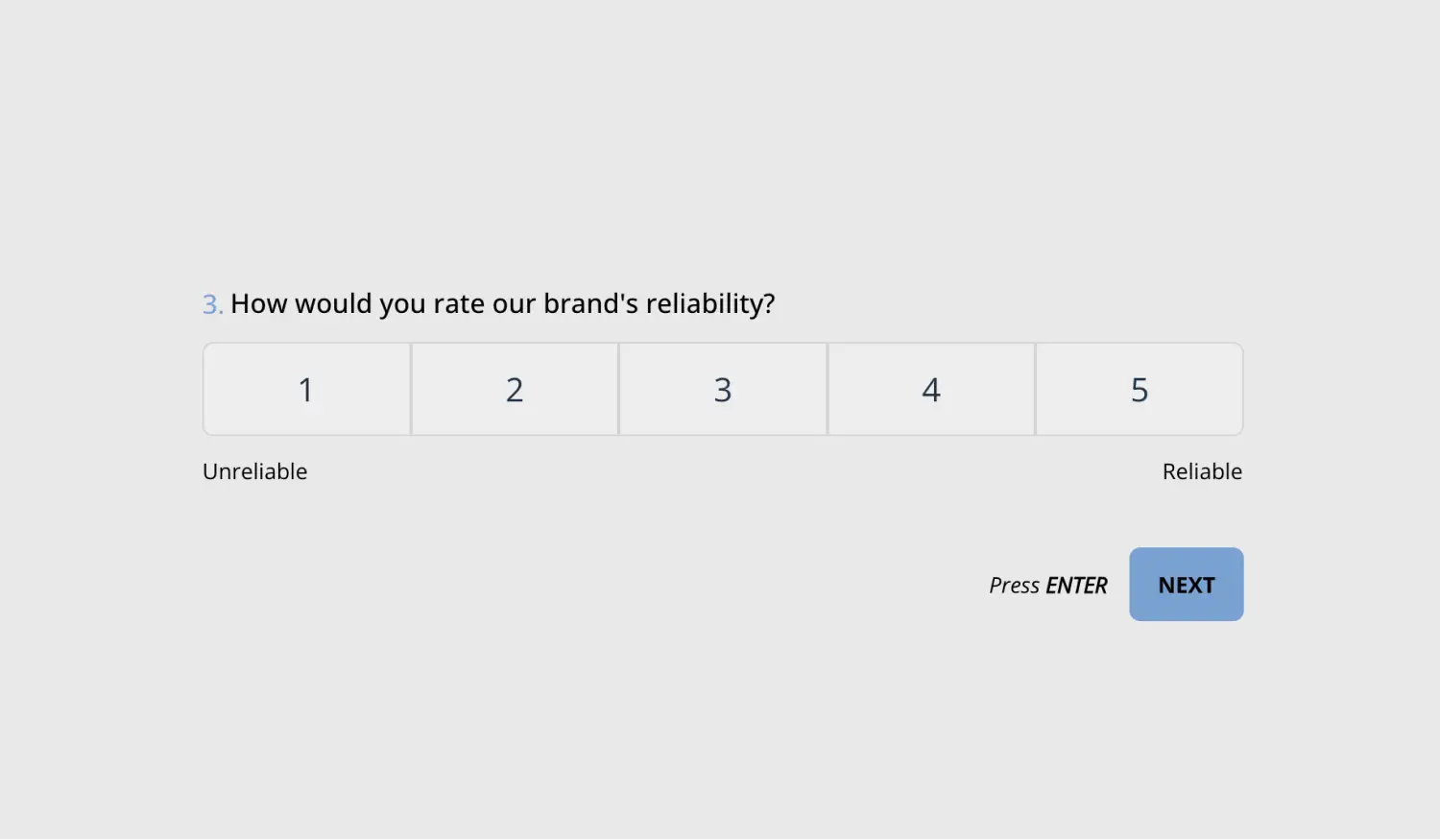
An example Semantic differential question
3- Rating scale surveys
Rating/opinion scale surveys ask respondents to rate a particular aspect of a product, service, or experience on a numerical scale such as 1 to 10. These surveys are very straightforward and effective for measuring the intensity of feelings or satisfaction. Companies commonly use them for customer feedback forms and employee performance evaluations.
You can use rating scale surveys for your product reviews as well. Rating scale surveys offer a simple but powerful way to gather quantitative data on attitudes. This ultimately makes it easier for you to identify trends and areas for improvement in your business/industry.
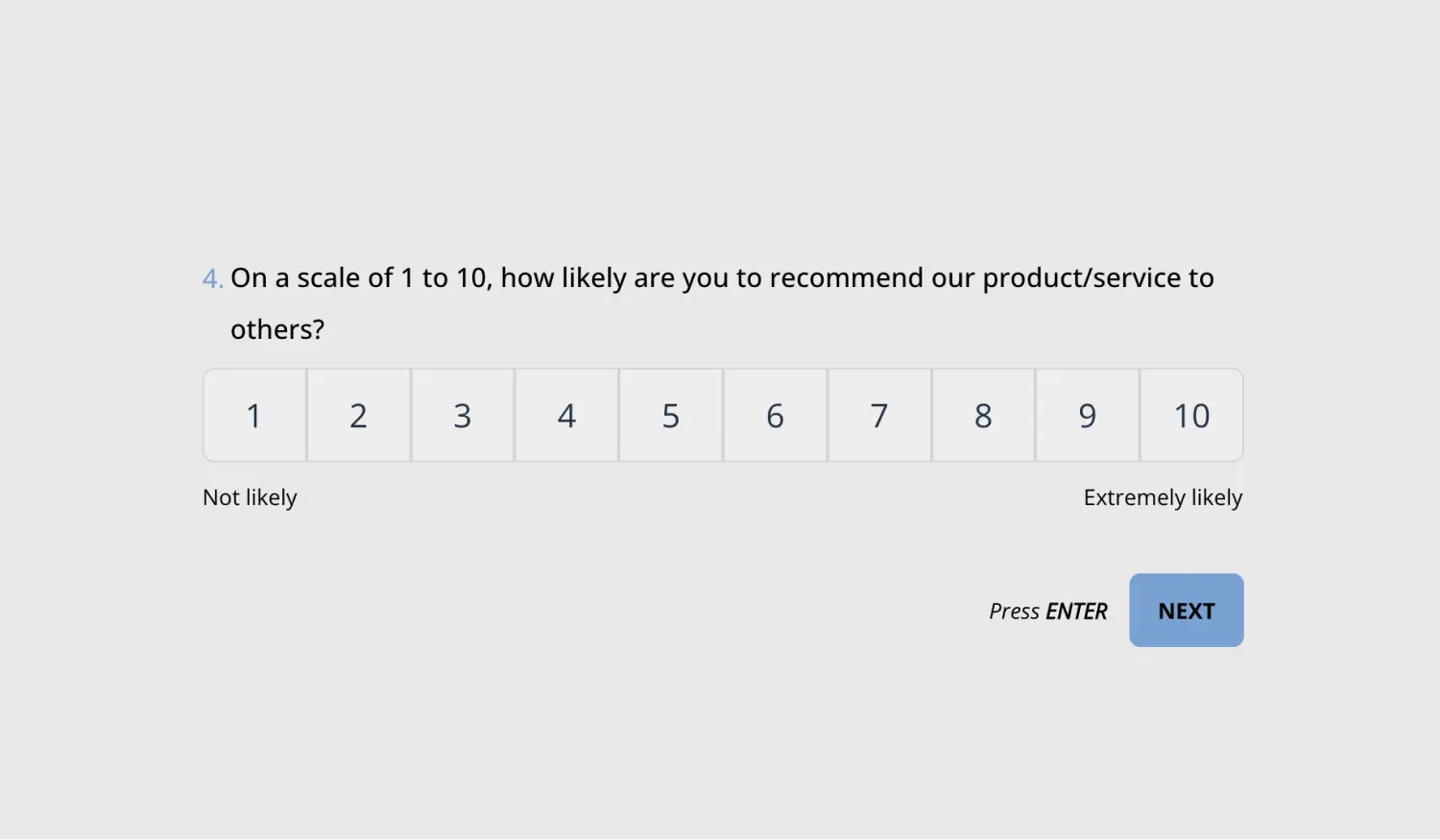
An example rating scale question
4- Open-ended surveys
Open-ended surveys allow respondents to answer questions in their own words. It provides qualitative insights into their attitudes, beliefs, and experiences. Unlike structured surveys, open-ended surveys do not restrict responses. It allows for more detailed and personalized feedback for your business.
You can often use these surveys for exploratory research, customer interviews, and focus groups. The data collected can be more challenging for you to analyze as it is not quantitative. However, it offers a deeper understanding of the underlying reasons behind people’s attitudes and behaviors toward your products or services.
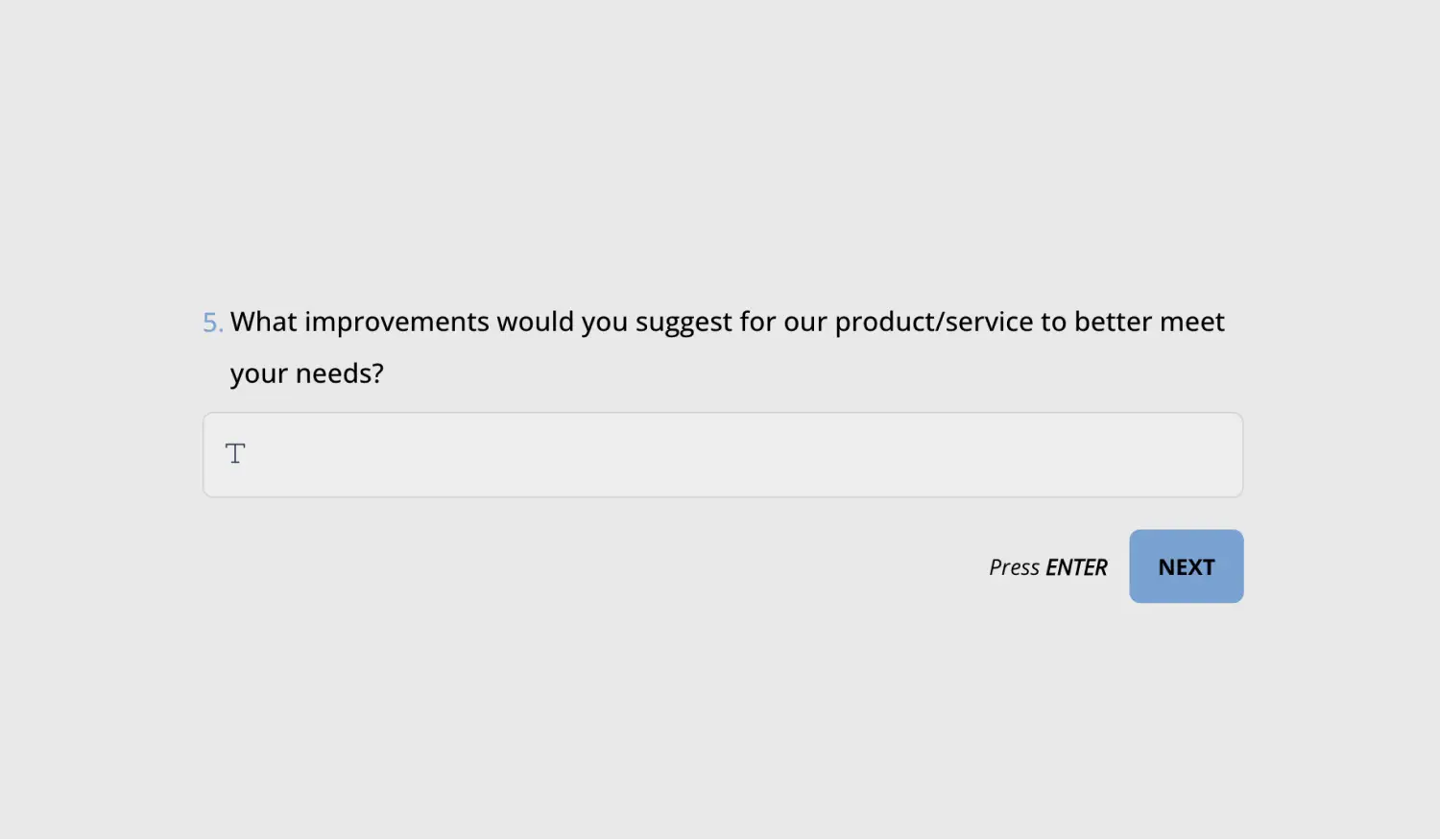
An example Open-ended question
5- Multiple-choice surveys
Multiple-choice surveys present respondents with a list of predefined options to choose from. This feature makes them easy to manage and analyze. Businesses often use these surveys to measure preferences, opinions, and attitudes on specific topics. Multiple-choice surveys are common in market research.
You can also use it for customer satisfaction studies and public opinion polls. They may not capture the depth of attitudes as open-ended surveys. But they provide clear and actionable data that you can use. This data will also be quantifiable and comparable to your business goals.
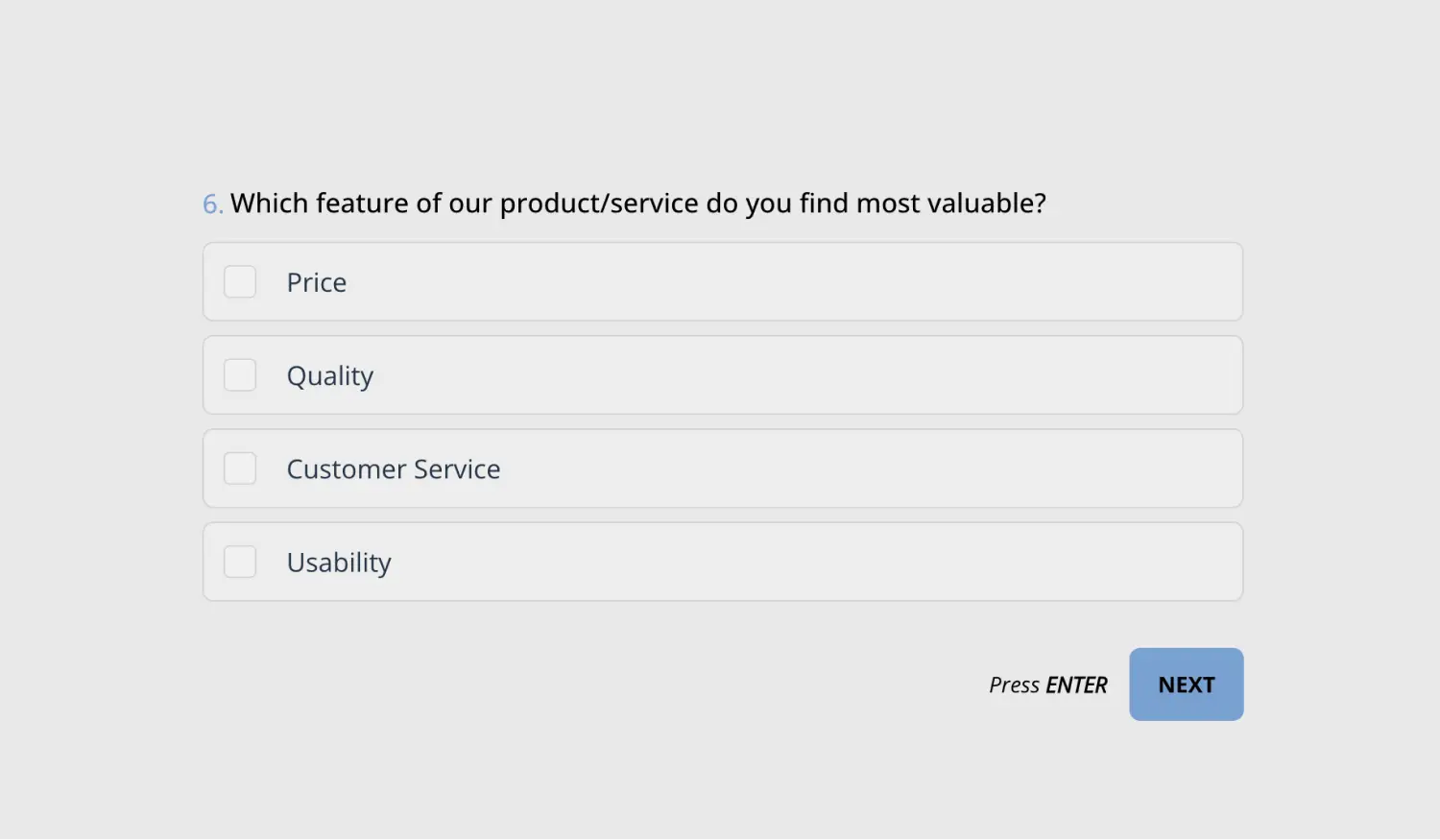
An example multiple choice question
6- Hybrid surveys
Hybrid surveys combine multiple types of questions in a single survey. This approach offers a comprehensive way to capture respondents’ attitudes. You do not have to choose whether your survey will be qualitative or quantitative. You can use different question types and measure the intensity of your target audience’s feelings.
This versatility makes hybrid surveys highly effective. You can capture a fuller picture of the respondents’ attitudes. Your business can gain deeper and more actionable insights if you can leverage the strength of each question type in a single survey.
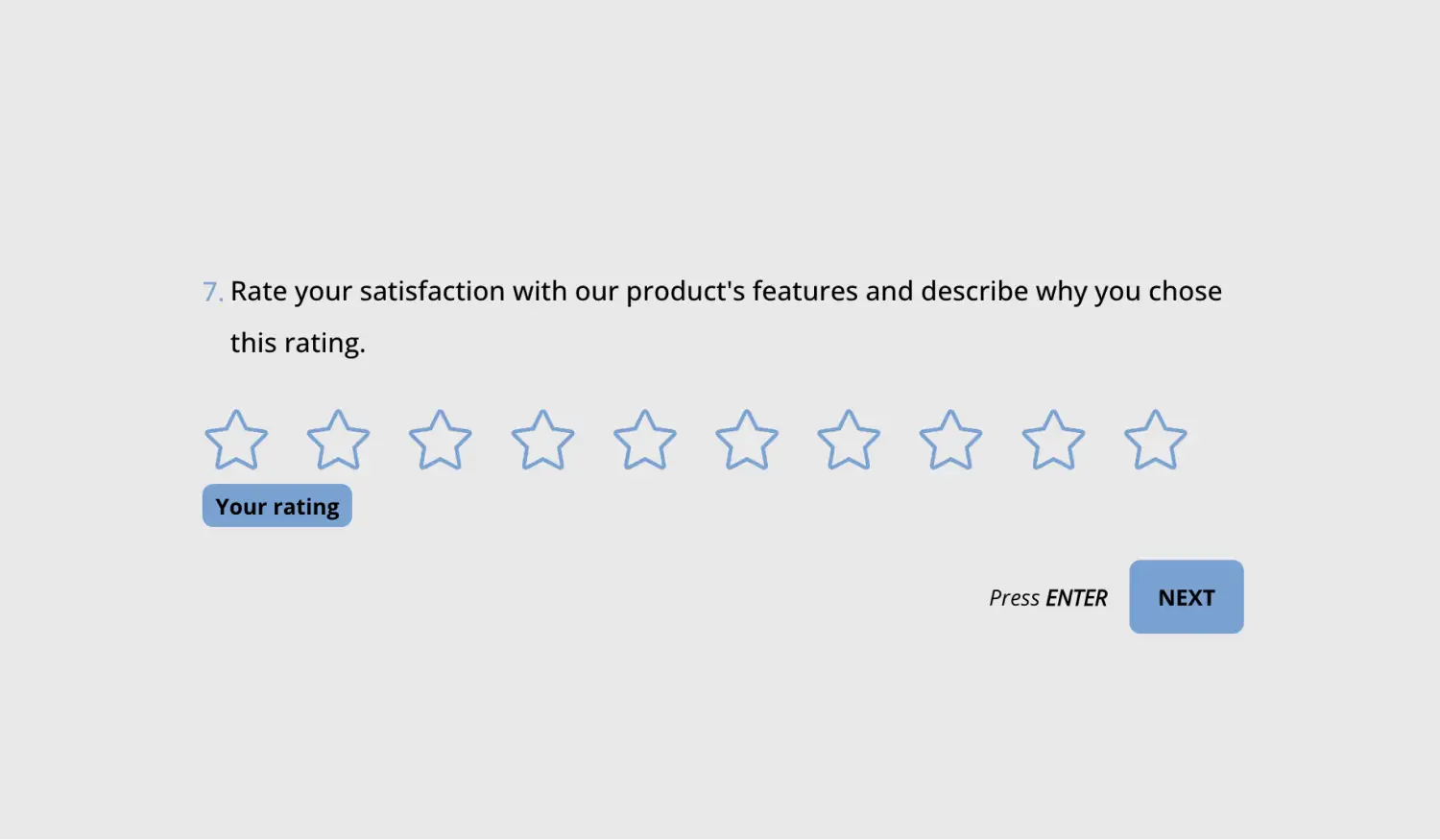
An example Hybrid question
When to use the attitudinal surveys?
We have seen different types of attitudinal surveys, and their benefits depend on your business goals. Now, let’s dive into when you can use the attitudinal survey and get positive results. We recommend you pay attention here as your business may fall under one of these categories.
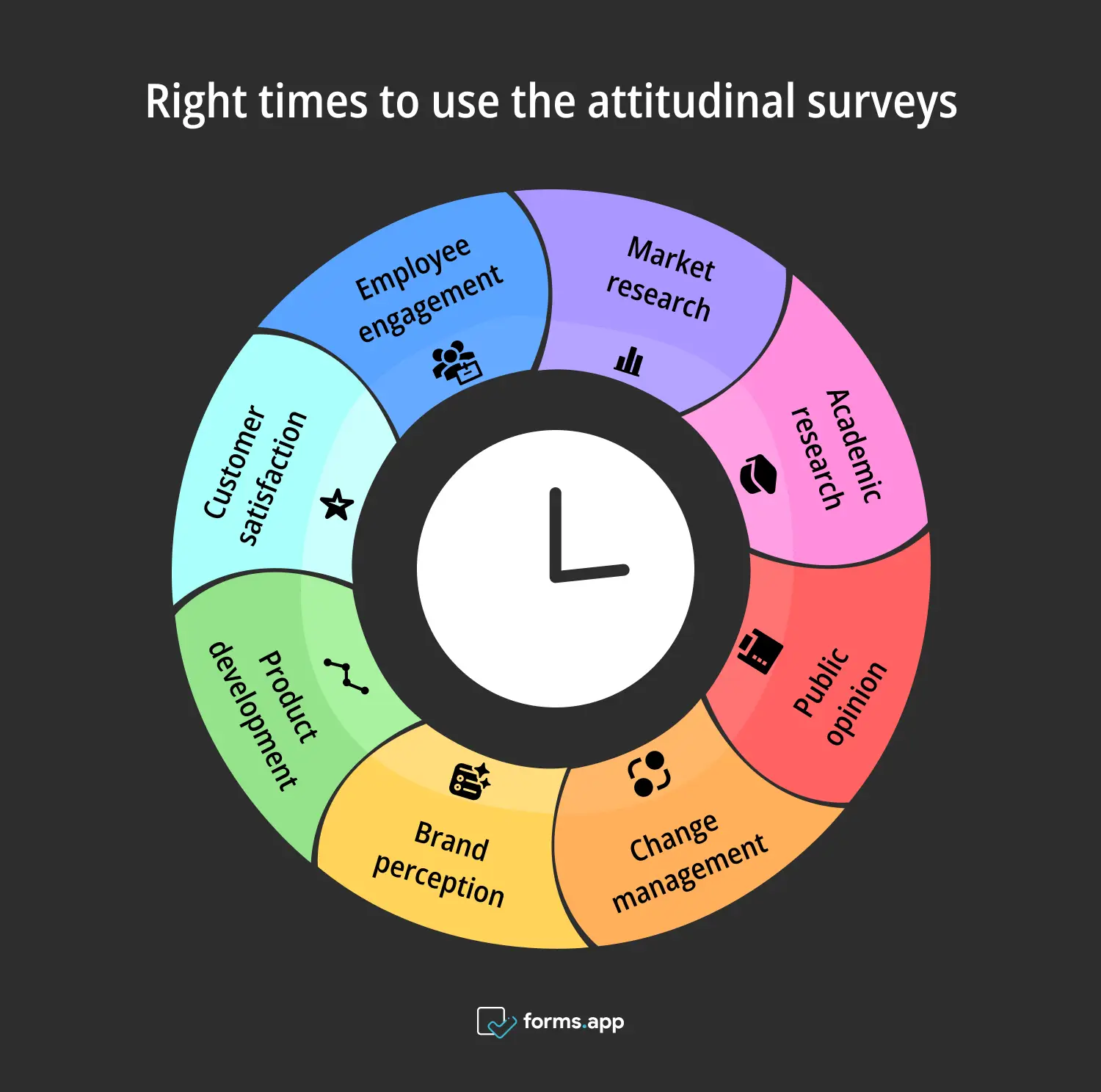
Correct times to use the attitudinal surveys
1. Market research
Attitudinal surveys are essential in market research when you need to understand consumer preferences, opinions, and motivations. They help you identify what drives consumer decisions and how they perceive different brands or products. You can use this information to develop marketing strategies aligning with the target audience. You can also improve product offerings and position your brand effectively.
2. Employee engagement
You can use attitudinal surveys to improve employee satisfaction in your company. You need to understand your employees’ attitudes toward their work environment, management, and organizational policies. Then, you can implement changes to improve workplace culture and boost productivity. These surveys are often part of larger employee management programs aimed at retaining talent and reducing turnover.
3. Customer satisfaction
Attitudinal surveys play a crucial role in measuring customer satisfaction. They help your business understand how customers feel about your products, services, and overall experience with the brand. This feedback is invaluable for your business because it identifies strengths and areas for improvement. You can address customer concerns, enhance satisfaction, and build stronger customer loyalty.
4. Product development
During product development, attitudinal surveys can provide insights into what features or aspects of a product are most important to potential users. Understanding customer attitudes towards different product features can guide your design decisions. This ensures that the product meets customer expectations and reduces the risk of product failure. These surveys are very useful in the early stages of product development.
5. Brand perception
Businesses often use attitudinal surveys to assess how customer groups perceive their brands. These surveys can reveal whether they associate your brand with positive or negative attributes. It also provides insights into how it compares to competitors and what factors influence brand loyalty. This information is critical for you to refine your brand messaging and marketing efforts.
6. Change management
Attitudinal surveys are valuable during times of organizational change, such as mergers, acquisitions, or restructuring. They help leaders understand employees’ attitudes toward the change, identify potential resistance points, and address concerns proactively. You can measure the overall sentiment and create communication strategies. With the help of these, you can provide the necessary support and ensure a smoother transition.
7. Public opinion
Governments, NGOs, and other organizations often use attitudinal surveys to measure public opinion on social, political, economic, or environmental issues. These surveys help in understanding the population’s attitudes toward policies, programs, or campaigns. These results can guide decision-making, improve public communication, and increase the effectiveness of initiatives.
8. Academic research
Academics commonly benefit from attitudinal surveys to study attitudes, beliefs, and perceptions on various topics. Researchers use them to gather scientific data, test hypotheses, and contribute to the body of knowledge in fields such as psychology, sociology, and education. The data collected can provide valuable insights into human behavior and attitude.
How to create an attitudinal survey for free (without coding)
Now, let’s discuss how to create a free attitudinal survey without coding. You are at the right place! forms.app offers various free survey templates that you can customize. By creating online surveys, you can reach your audiences and analyze the data more easily. Here are 5 steps to effectively create an attitudinal survey:
1. Sign up and choose a template
Simply begin by signing up for a free account on forms.app. Once you are in, browse through the available free templates and select one that suits your needs. You can also start from scratch and customize every aspect of the survey to align with your goals. Choosing a template will save you time and ensure that your survey has a professional layout.

Choose a beginning option
If you can’t find your desired template but do not want to waste time starting from scratch, you can use the 'Generate with AI' option. Simply type what kind of survey you want to create, and it will pop up the right questions for you, and you can continue from there.
2. Customize your questions
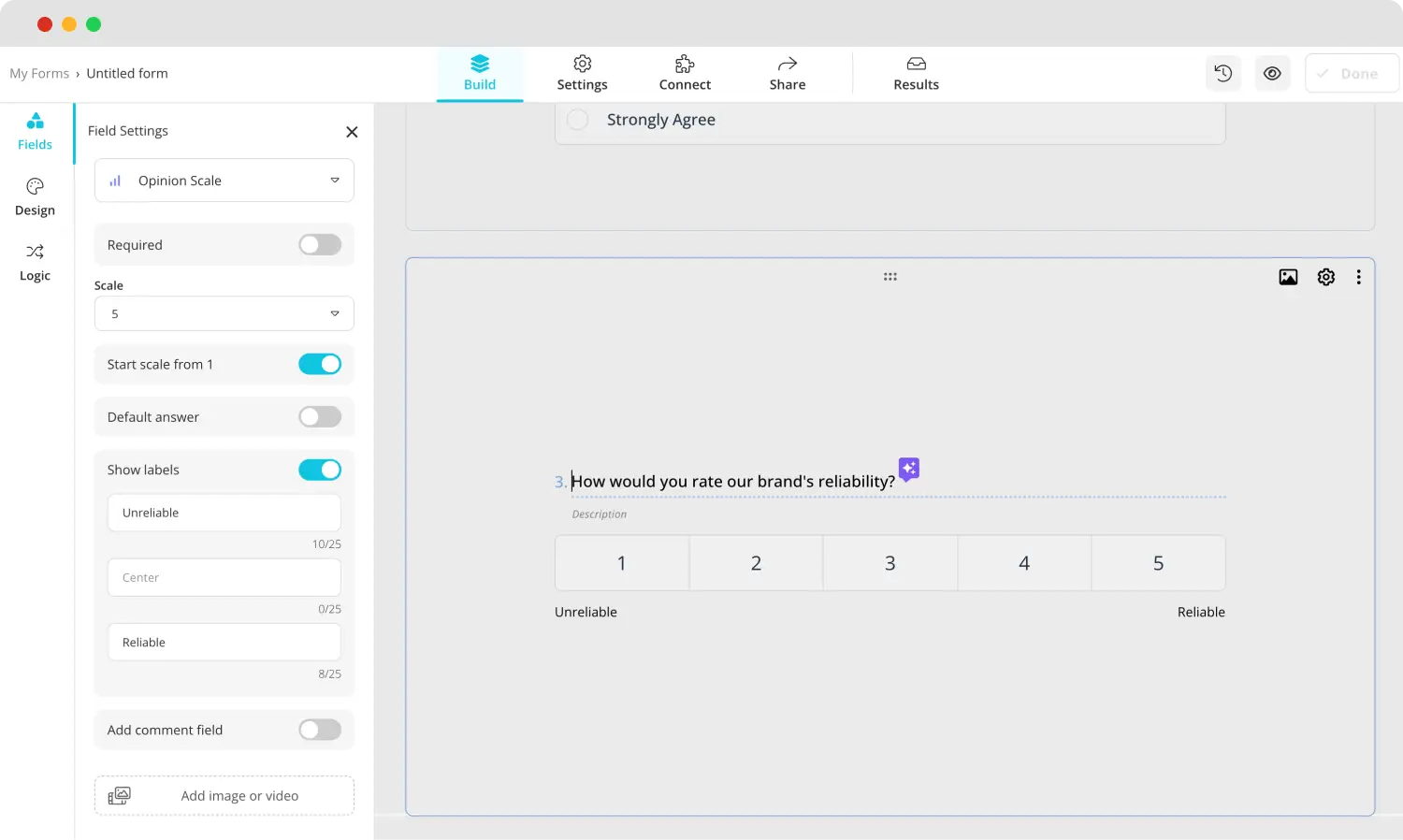
Add your own questions
After selecting a template, it’s time to customize the questions. forms.app allows you to add, remove, or modify questions with just a few clicks. Consider including a mix of Likert-scale, multiple-choice, and open-ended questions for an attitudinal survey. Make sure the questions are clear and relevant to the subject you are exploring. You can make it qualitative, quantitative, or a bit of both.
3. Adjust settings and logic
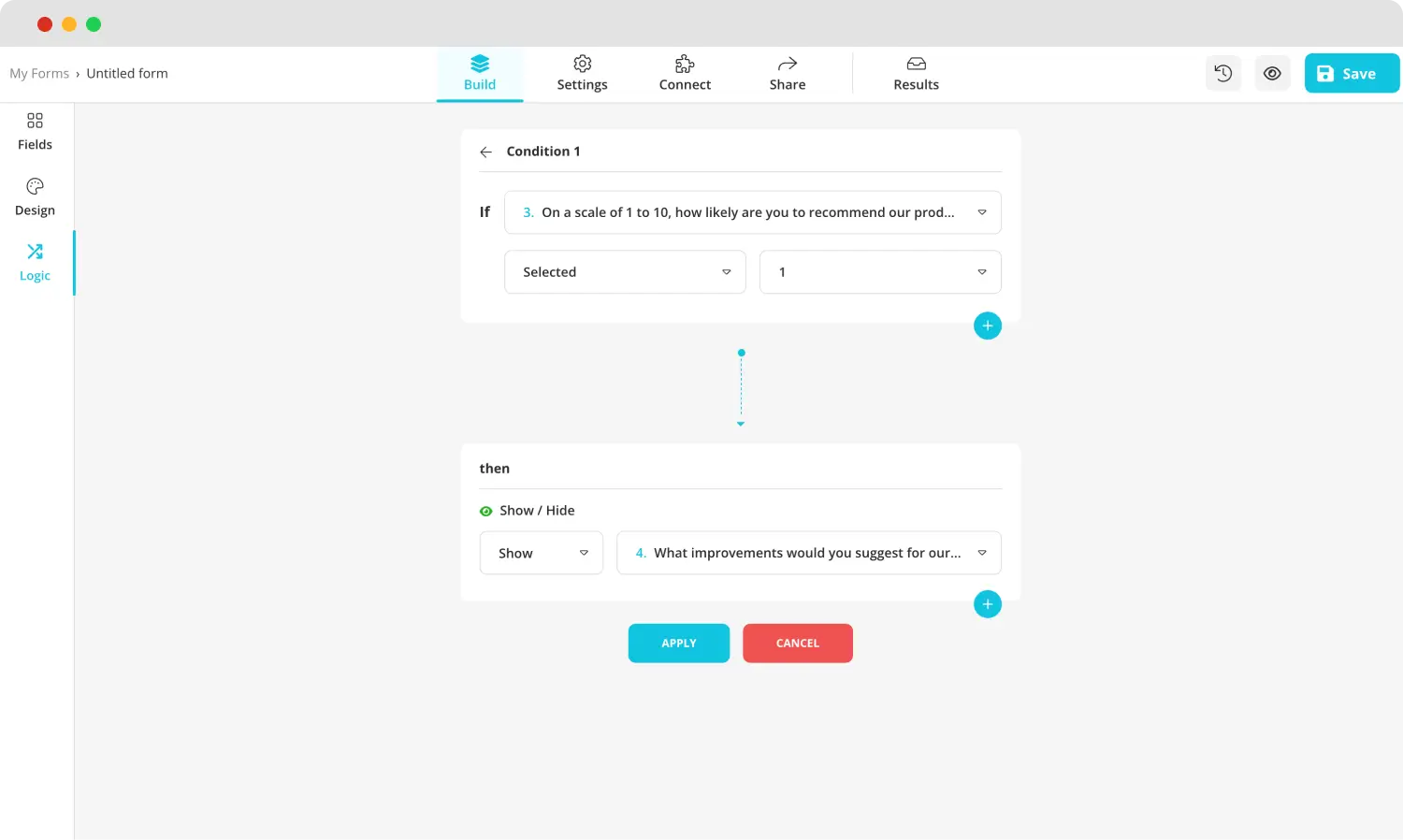
Use conditional logic if needed
forms.app provides various settings and logic options for editing your survey. You can set mandatory questions and control the survey flow with conditional logic. You can even customize a thank-you page. These features ensure that respondents have a smooth experience and that you gather the most relevant data.
4. Preview and test

Test your survey before sharing
After completing your survey, it is crucial to preview and test it before sharing. forms.app offers a preview mode that lets you see exactly how your survey will appear to respondents. Go through the survey yourself to check for any errors or inconsistencies. Testing the survey ensures that all logic flows correctly and the questions are clear.
5. Share and analyze
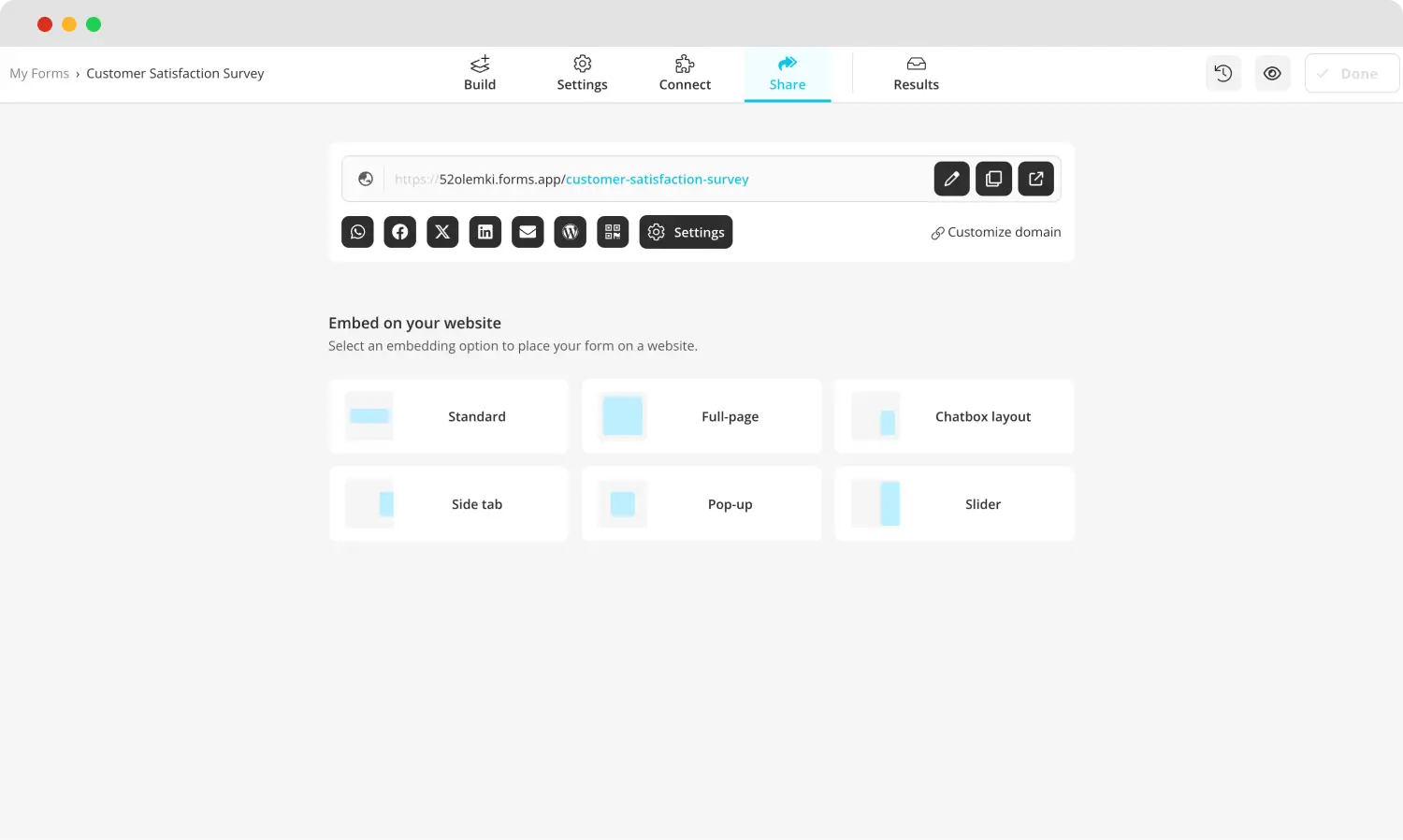
Share your survey
Once you finish testing, it is time to share your survey. We provide multiple sharing options, including links, QR codes, and even embedding options for websites. After collecting responses, you can use the platform’s built-in analytics tools to analyze the data. These tools allow you to view summary statistics, filter responses, and export data for further analysis.
30+ Example questions to ask in an attitudinal survey
Now that you know how to create an effective attitudinal survey for your business, we will give you some attitudinal survey questions. When creating your attitudinal survey, you can use many form fields such as opinion scales, selection matrix, star rating, and rankings that forms.app offers for free.
Here are some questions that you can see in an attitudinal survey example:
1. How satisfied are you with our product/service?
2. How likely are you to recommend our product/service to a friend or colleague?
3. How well does our product/service meet your needs?
4. How would you rate the quality of our customer support?
5. How would you describe your overall experience with our brand?
6. How confident are you in the value of our product/service?
7. What features do you find most valuable in our product/service?
8. What improvements would you like to see in our product/service?
9. How satisfied are you with the pricing of our product/service?
10. How likely are you to continue using our product/service?
11. How does our product/service compare to others you have used?
12. What is the primary reason you use our product/service?
13. How do you feel about the ease of use of our product/service?
14. How responsive have we been to your questions or concerns?
15. How aligned is our brand with your values and expectations?
16. How would you rate your overall experience with our website/app?
17. How satisfied are you with the timeliness of our service delivery?
18. How likely are you to purchase from us again?
19. What words would you use to describe our brand?
20. What suggestions do you have for improving our customer experience?
21. How does our product/service impact your daily life or work?
22. How important is sustainability in your purchasing decisions?
23. How satisfied are you with the variety of options available?
24. How effectively does our product/service solve your problems?
25. How well do our products/services align with your expectations?
26. How do you feel about the frequency of our communication with you?
27. What are your thoughts on our brand’s social responsibility efforts?
28. How do you feel about the personalization of our services?
29. How satisfied are you with the updates and new features we offer?
30. How well does our brand’s messaging resonate with you?
6 Expert tips for attitudinal surveys
We have covered many aspects of attitudinal surveys so far, but this may be your favorite part of the article. Here are 6 expert tips on how to create a successful and effective attitudinal survey. You can follow these tips to use attitudinal surveys and attain your business goals.

Attitudinal survey tips
1. Define clear objectives
Before designing your survey, establish clear objectives. Know what specific attitudes, beliefs, or perceptions you want to measure. This will guide your question development and ensure that the data you collect is relevant and actionable. Clear objectives help you focus the survey. It makes it easier to analyze the results and draw meaningful conclusions.
2. Keep your questions simple
Avoid complicated or ambiguous questions. If they, for example, include employee satisfaction survey questions, keep them simple to reduce the risk of misinterpretation. Ensure that your respondents can easily understand the questions and accurately reflect on their attitudes. This approach also helps you maintain engagement, as respondents are more likely to complete a survey that is easy to navigate.
3. Use the right question types
Include a mix of question types, such as Likert scales, multiple-choice and open-ended questions. This allows you to capture both quantitative and qualitative data. It provides a more comprehensive understanding of respondents’ attitudes. A variety of question types keeps the survey engaging and enables you to explore different dimensions of the attitudes being measured.
4. Keep your survey short
Long surveys can lead to respondent fatigue and result in lower completion rates and less thoughtful answers. Aim to keep your survey short and concise. Focus on essential questions that align with your objectives. A shorter survey increases the likelihood of full participation and reduces the risk of drop-offs. This, in turn, enables higher-quality data.
5. Preview your survey before publishing
Conduct a pre-test of your survey before launching it broadly. This helps to identify any confusing questions or technical issues. Pre-testing ensures that the survey functions as intended and that the questions effectively capture the desired information. It also provides you with an opportunity to make adjustments based on the initial review.
6. Analyze and act on the data
Collecting survey data is only the beginning. After gathering responses, thoroughly analyze the data to uncover key sights. Use these insights to inform decisions and make improvements. Acting on survey results shows respondents that you value their feedback, which will increase customer loyalty and overall satisfaction with your brand.
Frequently asked questions on attitudinal surveys
Attitudinal surveys focus on understanding people's feelings, beliefs, and opinions, while behavioral surveys measure actions and experiences. Attitudinal surveys explore the "why" behind behaviors, providing insights into motivations and perceptions. Behavioral surveys, on the other hand, capture what people do, offering concrete data on actions. Both types of surveys are complementary and valuable for comprehensive research.
The length of an attitudinal survey depends on its purpose, but it's generally recommended to keep it concise, around 10-15 questions. Longer surveys may lead to respondent fatigue, reducing the quality of the data. Focus on asking the most relevant questions to gather the necessary insights, and consider offering incentives to encourage completion.
Yes, attitudinal surveys are highly beneficial for small businesses. They provide valuable insights into customer satisfaction, brand perception, and employee engagement, helping small businesses make informed decisions and improve their operations. With free or affordable survey tools available, small businesses can easily create and distribute attitudinal surveys to gather the feedback needed for growth.
The frequency of conducting attitudinal surveys depends on the context and objectives. For ongoing employee engagement or customer satisfaction tracking, quarterly or biannual surveys are common. For specific projects, such as product launches or organizational changes, surveys can be conducted before and after the event. Regularly conducting surveys ensures that feedback is timely and actionable.
Final words
Attitudinal surveys are a powerful tool for understanding the feelings, beliefs, and opinions that drive behaviors. They offer deep insights that help your business make informed decisions, improve customer and employee satisfaction, and refine strategies. By carefully designing and analyzing these surveys, you can uncover valuable information that supports growth and success.
In this article, we have covered the definition, types, and uses of attitudinal surveys. We have provided you with some practical tips for creating free attitudinal surveys. We have also explored some example questions. Last but not least, we have answered some common queries.
Now, it is time to put this knowledge into practice. Start creating your survey in forms.app!
Fatih is a content writer at forms.app and a translator specializing in many text domains, including medical, legal, and technical. He loves studying foreign languages. Fatih especially likes to create content about program management, organizational models, and planning tools.
- What is an attitudinal survey?
- Attitudinal survey types
- When to use the attitudinal surveys?
- How to create an attitudinal survey for free (without coding)
- 30+ Example questions to ask in an attitudinal survey
- 6 Expert tips for attitudinal surveys
- Frequently asked questions on attitudinal surveys
- Final words
